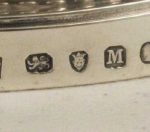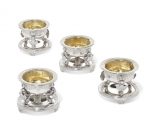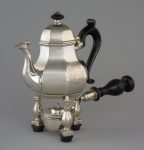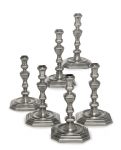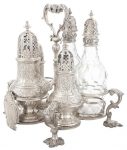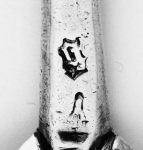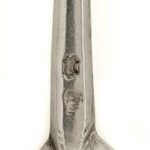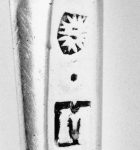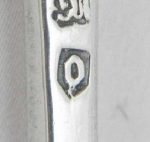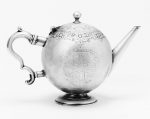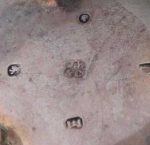London Hallmarks. London has been the most important British Assay Office for the high quality of workmanship and the amount and variety of silverware passing through it. The Goldsmiths Company was the first office in England, authorised to assay and mark gold and silver. This followed the granting of a Royal Charter in 1327. The London Assay Office is still in operation today. The Assay Mark for London is a leopard’s head.
A set of four Regency sterling silver master salt cellars from the Lonsdale Service by Benjamin Smith II, London; probably supplied by Rundell, Bridge and Rundell, 1808 The center of each stand engraved with a crest and coronet within the Order of the Garter, height 3 1/2in (9cm); diameter 4 1/2in (11.5cm); total weight approximately 72oz troy.
Sold for US$ 16,250 (£ 12,506) inc. premium at Bonhams in 2018
Teapot and lamp stand; silver; engraved with arms; London hallmarks 1706; maker’s mark. Made by: Louis Cuny Date 1706
Reference: © The Trustees of the British Museum
AN IMPORTANT SET OF SIX GEORGE I ROYAL SILVER CANDLESTICKS FIVE WITH MARK OF NICHOLAS CLAUSEN, LONDON, 1718, ONE APPARENTLY UNMARKED On stepped square bases with incurved corners, the circular wells rising to conforming square baluster stems and urn form sockets, the wells engraved with the Royal arms, five fully marked on undersides, one apparently unmarked, undersides with scratch weights and numbered X52-57 8 7/8 in. (22.7 cm.); 164 oz. 6 dwt. (5,110 gr.)
Sold for USD 206,250 at Christies in 2018
George II Sterling Silver Cruet Frame Samuel Wood, London, 1741 The cinquefoil stand on scroll feet the central handle with ring finial, fitted for three casters, each of baluster-form chased with foliate scrolls, and two glass bottles with silver caps. Height of stand 10 1/4 inches (26 cm), total approximately 76 ounces, weighable.
Sold for $4,062 (includes buyer’s premium) at Doyle New York in 2018
